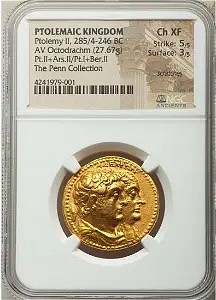Isaac II Angelus (AD 1185-1195). EL aspron trachy (29mm, 3.80 gm, 6h). NGC MS
Lot 131
Categories
Estimate:
$500 - $700
Absentee vs Live bid
Two ways to bid:
- Leave a max absentee bid and the platform will bid on your behalf up to your maximum bid during the live auction.
- Bid live during the auction and your bids will be submitted real-time to the auctioneer.
Bid Increments
| Price | Bid Increment |
|---|---|
| $0 | $10 |
| $100 | $25 |
| $500 | $50 |
| $1,000 | $100 |
| $5,000 | $250 |
| $10,000 | $500 |
| $20,000 | $1,000 |
| $50,000 | $2,000 |
| $100,000 | $2,500 |
| $200,000 | $3,000 |
About Auction
By Palmyra Heritage Gallery
Dec 18, 2022
Set Reminder
2022-12-18 12:00:00
2022-12-18 12:00:00
America/New_York
Bidsquare
Bidsquare : Exclusive Ancient Coins Sale
https://www.bidsquare.com/auctions/palmyra-heritage-gallery/exclusive-ancient-coins-sale-11543
Exclusive Ancient Coins Sale. End of the year just in time for the holidays! This sale consists of a wide range of Ancient coins from Ancient Greek, Roman, Byzantine, and Islamic. Palmyra Heritage Gallery info@palmyraheritagegallery.com
Exclusive Ancient Coins Sale. End of the year just in time for the holidays! This sale consists of a wide range of Ancient coins from Ancient Greek, Roman, Byzantine, and Islamic. Palmyra Heritage Gallery info@palmyraheritagegallery.com
- Lot Description
Isaac II Angelus (AD 1185-1195). EL aspron trachy (29mm, 3.80 gm, 6h). NGC MS 4/5 - 3/5, marks. Constantinople. Virgin, nimbate, enthroned facing, holding nimbate head of infant Christ on lap; barred MHP (ligate)-TV across fields / ICAAKIOC, Isaac II (on left), standing facing, wearing crown with pendilia and jeweled chlamys, cruciform scepter in right hand, akakia in left, Archangel Michael (on right), standing facing, wearing nimbus cruciger and military attire, reaching up with right hand to crown Isaac with right hand, jeweled scepter in left; O in middle field between heads, X/MI in right field. Sear 2002. Flashy surfaces. Isaac II came to power through the Constantinople mob's overthrow of Andronicus I. Only two months into his reign, he achieved a decisive and total victory over the invading Normans of Sicily at the Battle of Demetritzes, completely driving them from Byzantine territory. It was to be the only major success of Isaac's ten-year reign. Soon after the victory against the Normans, the Bulgarians revolted after 150 years of Byzantine rule, ending the period of unchallenged Byzantine dominance in the Balkans. On the other side of the empire, the relatively stable frontier with the Turks that had been established by his great-grandfather Alexius I Comnenus began to erode, as Isaac possessed neither the military competence of his predecessors nor sufficient interest in the eastern border due to his preoccupation with the futile struggle to reclaim Bulgaria. His attempt to impede the progress of the Third Crusade proved unsuccessful and counter to Byzantine interests. A weak administrator, Isaac watched passively as the power of the local provincial lords grew at the expense of the authority of Constantinople. The highly centralized Byzantine system of administration, which had ensured the empire's survival for hundreds of years and through numerous crises, was allowed to fall into permanent decay. He was overthrown and blinded by his brother Alexius in 1195, briefly returning to the throne on the eve of the Sack of Constantinople
- Shipping Info
-
SHIPPING FEES are the responsibility of the buyer. We can handle most of the shipping of the items we are selling, or we can recommend a local UPS Store to Handle it. All buyers will receive an invoice detailing their purchases, sales tax (if applicable), buyer's premium, and shipping/insurance charges. Items will be shipped only upon receipt of payment in full and will be insured for their full value. For shipments outside of the USA, customs and duties may apply upon entry in to host country, and this fee, if any, is the buyer's responsibility. We will not falsify customs value on international shipments! If you have questions about this, please inquire before bidding.
-
- Payment & Auction Policies
-
Available payment options
-
- Buyer's Premium



 EUR
EUR CAD
CAD AUD
AUD GBP
GBP MXN
MXN HKD
HKD CNY
CNY MYR
MYR SEK
SEK SGD
SGD CHF
CHF THB
THB













